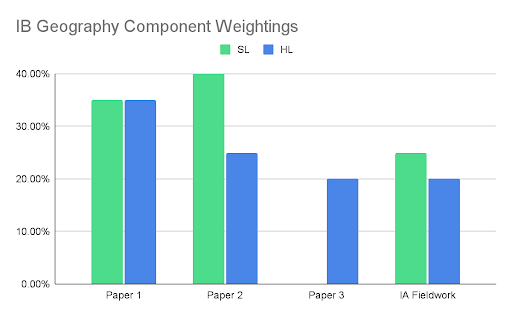Contents
What distinguishes the 7s from the 6s is not so much perfection but consistent performance across all components, precise use of case studies, and disciplined responses to command terms.
Moving towards a 7 means mastering assessment objectives (opens in a new tab) (AO1 knowledge, AO2 application, AO3 analysis and AO4 skills), practising timed responses for each paper, building an adaptable case-study bank, and producing a criteria-aligned fieldwork report.
What It Takes to Reach a 7
High-scoring students deliver reliable performances across every component: Paper 1 (Core Themes), Paper 2 (Options), Paper 3 for HL (Global Interactions), and the Internal Assessment (IA).
Grade boundaries vary each year, but a total higher than 80% is often needed for a 7. Focus on consistent execution, not perfection, and align your answers tightly to the assessment objectives.
Teacher Tip:
Plan for 1–2 minutes before writing longer responses. A clear structure turns knowledge into marks.
Paper Weighting and Component Strategy

The bar chart shows how the different pieces of the IB Geography curriculum are weighted for SL and HL. Always make sure you have the most up-to-date subject guide for your exam so that you can check for information such as this.
Component | SL Weight | HL Weight |
Paper 1: Core Themes | 35% | 35% |
Paper 2: Optional Themes | 40% | 25% |
Paper 3: Global Interactions | — | 20% |
Internal Assessment (IA) Fieldwork | 25% | 20% |
Teacher Tip:
You cannot ‘sacrifice’ a paper. The IA supports your overall grade but does not rescue weak examination performance; exam technique matters as much as content knowledge.
Paper-by-Paper Tactics
Paper 1: Optional Themes
Paper 1 rewards comparative, applied case studies in your chosen options (e.g., hazards, rivers, coasts, urban environments, tourism, food, and health).
Prepare two to three high-impact case studies per option.
Embed data inside analysis; avoid long ‘data dumps’ where you simply copy data from the graphs, maps etc....
Practice comparisons (e.g., Peru vs. Somalia water management) to demonstrate synoptic thinking.
Paper 2: Core Themes
Paper 2 assesses core content such as population distribution, global climate, and resource consumption, with responses driven by command terms.
Use precise, recent, location-specific examples rather than generic theory.
Provide the exact answer to the command words; ‘examine’ requires a different response and structure than ‘evaluate’.
Plan quickly, then write with purpose using a paragraph frame like PEEL (Point–Evidence–Explain–Link).
Paper 3 (HL Only): Global Interactions
Paper 3 focuses on conceptual understanding (e.g., development, power, and globalisation) and the interpretation of unseen data.
Use frameworks, such as indicators of development or the core-periphery model, to structure arguments.
Practice data-response questions—you must be able to explain and interpret them under pressure.
Case-Study Mastery
If you want to score a 7, case studies can’t be an afterthought. Case studies should come naturally to you – they should not be memorised essays but rather flexible, precise examples that you can adapt to any question.
A strong case-study bank is precise, brief and adaptable; it includes locations, statistics, processes and outcomes that you can apply in varied contexts.
How Many Case Studies?
Core Themes (Paper 1): 2–3 per theme.
Each Option (Paper 2): 3–4 in-depth studies.
Paper 3 (HL): 5–6 diverse examples across regions and income levels.
Choosing Powerful, Diverse Examples
A good case study isn’t just relevant—it’s impactful. Choose examples that:
Contrast geographically (e.g., an LIC vs an HIC).
Highlight different impacts (social, economic, environmental)
Tie into theory (like risk vulnerability models or urbanisation pathways). For example:
Theme | Case Study | Key Concept | Spatial Context |
Climate Change | Bangladesh, South Asia (sea-level rise) | Vulnerability & adaptation | The delta of the Ganges and Brahmaputra (Jamuna) rivers, bordering India and Myanmar with the Bay of Bengal to the south |
Urban Environments | Rio de Janeiro, Brazil | Traffic planning | On the Atlantic coast with coastal plains, hills, and mountains |
Hazards | Christchurch, NZ | Land use zoning | South Island (NZ) in the southwestern Pacific Ocean |
Build a Case-Study Bank
Create a simple sheet with location/background, key stats, processes, outcomes, evaluation points, and synoptic links. Revisit using active recall and spaced repetition.
Internal Assessment (IA)
The IA must have a clear, spatially focused research question that allows primary data collection and analysis within 2,500 words.
Good vs Weak Questions
Your research question should avoid vague or unmeasurable titles.
Strong: ‘To what extent does slope angle affect soil erosion rates along the River X in [location]?’
Weak: ‘How is climate change affecting my town?’
Data and Methods
Collect quantitative data, and use sketches, maps and diagrams that demonstrate effort and detail. Where feasible, include basic statistics and Geographic Information System (GIS) outputs to strengthen causal claims.
Criterion | What Examiners Look For |
Fieldwork Question | Clear, geographical, spatially focused |
Method(s) | Justified, appropriate, replicable |
Quality of Data | Reliable, well-presented, wide-ranging |
Analysis | In-depth, uses statistics and theory |
Evaluation | Limitations, reflection, next steps |
Top tip:
Constantly check your work against the IA rubric (instructions/guidelines) – it's an invaluable tool.
Command Terms & Mark-Scheme Thinking
Misreading command terms is a major cause of lost marks; each verb implies a specific structure and depth.
Describe
State what you see with accurate detail.
Explain
Provide reasons and mechanisms using theory.
Examine
Consider different perspectives with evidence.
Evaluate
Judge effectiveness and justify a conclusion.
To what extent
Build a balanced argument that reaches a defensible judgement.
Use PEEL or SEA (Statement–Evidence–Analysis) to keep paragraphs focused and exam-aligned.
Weekly Study Routine
Top students don’t just revise more—they revise smarter. Here’s how to tailor your revision to guarantee results.
Instead of cramming the night before, use spaced repetition, which involves revisiting content at increasing intervals to improve memory retention.
Build flashcards and quizzes
Mind maps help you connect different topics and visualise information effectively.
Focus on question-based learning by testing yourself before reviewing your notes.
Take breaks to avoid burnout (use the Pomodoro technique: 25-minute study sessions with 5-minute breaks)
Every few weeks:
Mark your work using real examiner reports.
Highlight where you met (or missed) the assessment objectives.
Ask your teacher for feedback and ACT on it
Teacher Tip:
Short, regular, active sessions outperform long, passive reading for long-term retention.
Day | Activity |
Monday | Flashcards (case studies, 15 minutes) + quick note review |
Tuesday | Write one 10-mark essay under timed conditions |
Wednesday | Paper 1 review + mark-scheme decoding |
Thursday | IA edits or data reflection |
Friday | Paper 2 past question + feedback |
Weekend | HL Paper 3 practice (if HL) + self-assessment + rest |
FAQs
What percentage do I need for a 7 in IB Geography?
The average score for a 7 in IB Geography typically exceeds 80%, although grade boundaries change annually. Always aim for a consistent performance across all the components rather than chasing perfection.
Do I need to memorise case studies word for word?
No. Know key statistics, locations, and outcomes so you can adapt examples to the exact question asked.
How long should my IA be?
Your IA should not exceed 2,500 words. Keep it concise, analytical and criterion-aligned.
Is HL Paper 3 much harder?
It is more abstract and conceptual, emphasising frameworks and arguments. Practice interpreting unfamiliar data and linking it to theories.
Final Thoughts
Key Reminders for Top Performance
IB Geography 7 → requires → consistent high performance across P1, P2, P3 and the IA
Paper 1 Options → rewards → comparative, applied case studies
Paper 2 Core → assesses → population, climate and resources
Paper 3 HL → emphasises → conceptual, synoptic and understanding
Internal Assessment → demands → focused, spatial question with primary data
Command terms → determine → structure and depth of response
Case study bank → improves → adaptability and precision
Check out our helpful guide for top tips on how to revise for IB Geography.
Boost Your Grades With Save My Exams
Feeling stressed about your IB Geography exams? Join over 1.5 million students who use Save My Exams, the leading online revision platform.
On average, students who use Save My Exams improve by two grades, thanks to our comprehensive resources. Our revision resources, which include exam-style questions customised for your particular course as well as past papers and revision notes, help you study more effectively rather than more tediously.
Created by teachers and examiners who know exactly what you need to revise to achieve the best grades, our resources help students save time and get straight to the content you need.
Explore Our DP IB Geography: SL Revision Notes
Explore Our DP IB Geography: HL Revision Notes
References & Sources
International Baccalaureate Organisation (IBO). Geography Subject Guide. IBO website (opens in a new tab).
International Baccalaureate Diploma Programme Subject Brief: Geography. IBO PDF (opens in a new tab)
Past papers and markschemes. IBO website (opens in a new tab)
Sign up for articles sent directly to your inbox
Receive news, articles and guides directly from our team of experts.

Share this article
 written revision resources that improve your
written revision resources that improve your